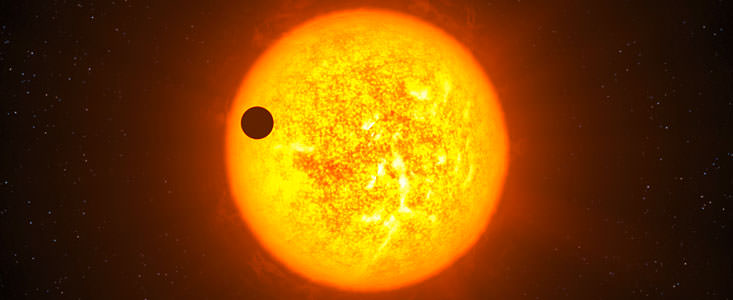[/caption]
Chalk up another exoplanet discovery for the CoRoT satellite. But this planet, while a gas giant, could have temperatures cool enough to host liquid water. Corot-9b orbits a sun-like star at a distance similar to Mercury – one of the largest orbits of any extrasolar planet yet found, and may have an interior that closely resembles Jupiter and Saturn. “This is a normal, temperate exoplanet just like dozens we already know, but this is the first whose properties we can study in depth,” said Claire Moutou, who is part of the international team of 60 astronomers that made the discovery. “It is bound to become a Rosetta stone in exoplanet research.”
Corot-9b (unofficial nickname Carrot Nimby) regularly passes in front of its star, located 1,500 light-years away from Earth towards the constellation of Serpens (the Snake), allowing astronomers to view the planet for 8 hours at a time. The transits occur every 95 days.
“Our analysis has provided more information on Corot-9b than for other exoplanets of the same type,” says co-author Didier Queloz. “It may open up a new field of research to understand the atmospheres of moderate- and low-temperature planets, and in particular a completely new window in our understanding of low-temperature chemistry.”
The star Corot-9b orbits is slightly cooler than our sun, so the astronomer estimate that Corot-9b’s temperature could lie somewhere between -23°C and 157°C.
Corot-9b has a radius around 1.05 times that of Jupiter but only 84% of the mass. This leads to a density of 0.90 g/cc, or 68% that of Jupiter.
More than 400 exoplanets have been discovered so far, 70 of them through the transit method. Astronomers say Corot-9b is special in that its distance from its host star is about ten times larger than that of any planet previously discovered by this method. And unlike all such exoplanets, the planet has a temperate climate. The temperature of its gaseous surface is expected to be between 160 degrees and minus twenty degrees Celsius, with minimal variations between day and night. The exact value depends on the possible presence of a layer of highly reflective clouds.
“Like our own giant planets, Jupiter and Saturn, the planet is mostly made of hydrogen and helium,” said team member Tristan Guillot, “and it may contain up to 20 Earth masses of other elements, including water and rock at high temperatures and pressures.”
This team’s findings were published in this week’s edition of the journal Nature. (“A transiting giant planet with a temperature between 250 K and 430 K”), by H. J. Deeg et al.”)
Sources: ESO, EurekAlert


Now we are moving towards the tail of the distribution (but not really), and I like what I can see of that tail!
[Sorry, it is spring here, after an unusually cold and snowy winter. My thoughts are put out for spring pasture, so they are bound to take some hormonally influenced side leap now and then. Don’t mind them – I don’t. :-o]
“Corot-9b orbits a sun-like star at a distance similar to Mercury – one of the largest orbits of any extrasolar planet yet found”
Sorry, incorrect as stated. 😛
It’s one of the largest orbits of a TRANSITING planet yet found, and the only one with a ~ 100 day orbit which is nearly circular – the two others are “magma divers”.
The largest orbit found by radial velocity is several years.
Speaking of transits, the Extrasolar Planets Encyclopaedia posted a series of exoplanets (now totaling 443 candidates) today. The lowest mass one @ 4.2 Earth masses out-masses (in-masses?; sets a new low mass record) the earlier most mentioned record holder I believe, and has slightly larger period @ 4.6 days.
I would dearly want to know more about the current stat trends on Super-Earths. When will we see the first Earth mass one?
Oh, and in any case expecting “close(r) to 500 exoplanets” any week now. 😀
Maybe this planet has a nice balmy moon.
gread picture!
How is it possible for this planet to have such a low temperature? Wouldn’t it be scalding hot because of all the atmosphere absorbing all of the heat from the sun, which is supposedly like ours? Why does Mercury, which has a similar orbit, get so much hotter?